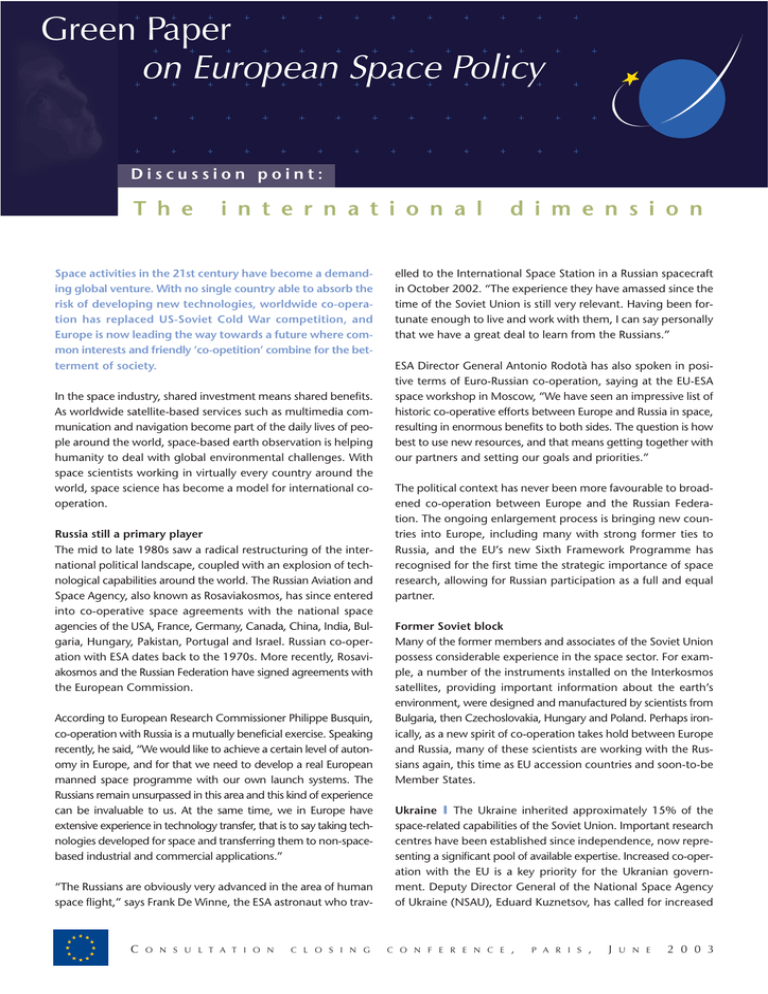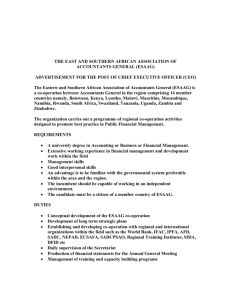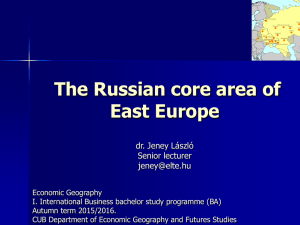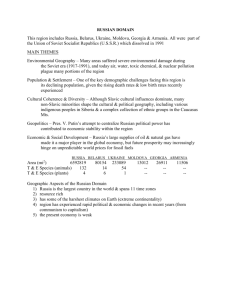Green Paper on European Space Policy
advertisement

Green Paper on European Space Policy Discussion point: T h e i n t e r n a t i o n a l Space activities in the 21st century have become a demanding global venture. With no single country able to absorb the risk of developing new technologies, worldwide co-operation has replaced US-Soviet Cold War competition, and Europe is now leading the way towards a future where common interests and friendly ‘co-opetition’ combine for the betterment of society. In the space industry, shared investment means shared benefits. As worldwide satellite-based services such as multimedia communication and navigation become part of the daily lives of people around the world, space-based earth observation is helping humanity to deal with global environmental challenges. With space scientists working in virtually every country around the world, space science has become a model for international cooperation. Russia still a primary player The mid to late 1980s saw a radical restructuring of the international political landscape, coupled with an explosion of technological capabilities around the world. The Russian Aviation and Space Agency, also known as Rosaviakosmos, has since entered into co-operative space agreements with the national space agencies of the USA, France, Germany, Canada, China, India, Bulgaria, Hungary, Pakistan, Portugal and Israel. Russian co-operation with ESA dates back to the 1970s. More recently, Rosaviakosmos and the Russian Federation have signed agreements with the European Commission. According to European Research Commissioner Philippe Busquin, co-operation with Russia is a mutually beneficial exercise. Speaking recently, he said, “We would like to achieve a certain level of autonomy in Europe, and for that we need to develop a real European manned space programme with our own launch systems. The Russians remain unsurpassed in this area and this kind of experience can be invaluable to us. At the same time, we in Europe have extensive experience in technology transfer, that is to say taking technologies developed for space and transferring them to non-spacebased industrial and commercial applications.” “The Russians are obviously very advanced in the area of human space flight,” says Frank De Winne, the ESA astronaut who trav- C European O N S U L T A T I O N C L O S I N G d i m e n s i o n elled to the International Space Station in a Russian spacecraft in October 2002. “The experience they have amassed since the time of the Soviet Union is still very relevant. Having been fortunate enough to live and work with them, I can say personally that we have a great deal to learn from the Russians.” ESA Director General Antonio Rodotà has also spoken in positive terms of Euro-Russian co-operation, saying at the EU-ESA space workshop in Moscow, “We have seen an impressive list of historic co-operative efforts between Europe and Russia in space, resulting in enormous benefits to both sides. The question is how best to use new resources, and that means getting together with our partners and setting our goals and priorities.” The political context has never been more favourable to broadened co-operation between Europe and the Russian Federation. The ongoing enlargement process is bringing new countries into Europe, including many with strong former ties to Russia, and the EU’s new Sixth Framework Programme has recognised for the first time the strategic importance of space research, allowing for Russian participation as a full and equal partner. Former Soviet block Many of the former members and associates of the Soviet Union possess considerable experience in the space sector. For example, a number of the instruments installed on the Interkosmos satellites, providing important information about the earth’s environment, were designed and manufactured by scientists from Bulgaria, then Czechoslovakia, Hungary and Poland. Perhaps ironically, as a new spirit of co-operation takes hold between Europe and Russia, many of these scientists are working with the Russians again, this time as EU accession countries and soon-to-be Member States. Ukraine I The Ukraine inherited approximately 15% of the space-related capabilities of the Soviet Union. Important research centres have been established since independence, now representing a significant pool of available expertise. Increased co-operation with the EU is a key priority for the Ukranian government. Deputy Director General of the National Space Agency of Ukraine (NSAU), Eduard Kuznetsov, has called for increased C O N F E R E N C E , P A R I S , J U N E 2 0 0 3 collaboration between the Ukraine and Europe in space. Speaking at the first meeting of the ‘EU-Ukraine Joint ad hoc Working Group on Peaceful Use of Outer Space’ in March 2003, Kuznetsov offered to modify the Ukraine’s long-term space programme with the objective of integrating it into the emerging EU space strategy. The development of space co-operation with the Ukraine was referred to explicitly in the EU-Ukraine Partnership and Co-operation Agreement of March 2000. Poland I Zbigniew Klos of the Polish Academy of Sciences’ Space Research Centre has said, “The development of a common space research strategy is a great challenge for all of the countries of Europe, including for those of us preparing to join the European Union. Poland has come a long way, starting from the days of the Interkosmos programme and now as a full research partner with the EU. This comes as Polish legislators are finally recognising the indispensable nature of space research for all sorts of applications – environmental monitoring, to name just one.” The United States – a long-standing partnership Europe’s relations with the United States with respect to space have been privileged, given the family links of scientific, technological and industrial cultures. Europe and the United States therefore have a long history of co-operative exchange in space on many levels. Europe is a partner of the USA, along with Russia, Canada, and Japan, in the International Space Station (ISS), one of the largestever co-operative ventures in science and technology. ESA’s primary contribution is the Columbus laboratory. Europe’s impressive long-term efforts in the area of launcher technologies has made it the main competitor of the USA in the commercial launch field, but EU officials do not see the need to class the Americans as competitors in the absolute sense. Co-operation in appropriate areas will continue to be beneficial to all partners, while the stimulus of economic competition can contribute to maintaining the commercial and industrial sectors leading to a healthy sense of ‘co-opetition’. Emerging space players The USA, Russia and the EU are by no means the world’s only space faring communities. More than ever, space exploration is a global adventure and the major space projects of the future are likely to be undertaken by partnerships representing humankind as a whole. Europe is currently forging closer ties with a number of lesserknown but highly motivated and dynamic space players. C European O N S U L T A T I O N C L O S I N G Canada I Canadian activities in space are extensive for a country of its small population. Since 1978, a far-reaching co-operation agreement has existed between Canada and ESA. Canada and the Canadian space industry have actively participated in many ESA programmes. Canada participates directly in ESA decision-making and Canadian companies bid for and receive contracts on the same basis as their European counterparts. The EU and Canada have developed close contacts in global satellite navigation. A joint Working Group on Satellite Navigation was set up in 1999 by the EC and Canada. Canada also participated in GALILEO definition phase studies, providing expertise and funding. Japan I The Japanese Space Agency, NASDA, has been extremely busy over the past few years with a number of successful space programmes. Japanese triumphs include the H2 space launcher. China I Learning lessons from both the Russians and the Americans, the Chinese have created a credible space enterprise. The Chinese have developed their launch capability into a flourishing commercial enterprise by lowering the prices substantially, cutting into the European and American markets. Several different countries have used Chinese launchers successfully. India I India comprises some one billion people living within a country with a vast north-to-south expanse and requiring a highly advanced communications system. The country is also heavily reliant on agriculture, which makes remote sensing and meteorological data a vital necessity. India has wasted no time in establishing an autonomous space capability. Formerly dependent on the USA and the Soviet Union for their space vehicles, India has now developed its own indigenous remote sensing satellite. As Landsat 4 and 5 become outmoded, the US is likely to have to rely upon India to feed its remote sensing database. In addition to these, a few developing countries have advanced their status by launching their own rockets and in some cases their own satellites. To co-operate or not to co-operate? Given Europe’s accomplishments in space, it is clearly capable of taking the initiative, performing on a par with its major partners and playing a key strategic role in major space projects. But what should the criteria be for deciding when to work together and when to go it alone? The Commission’s Green Paper on a European Space Policy calls for a review among European stakeholders of just what the proper balance should be. C O N F E R E N C E , P A R I S , J U N E 2 0 0 3







